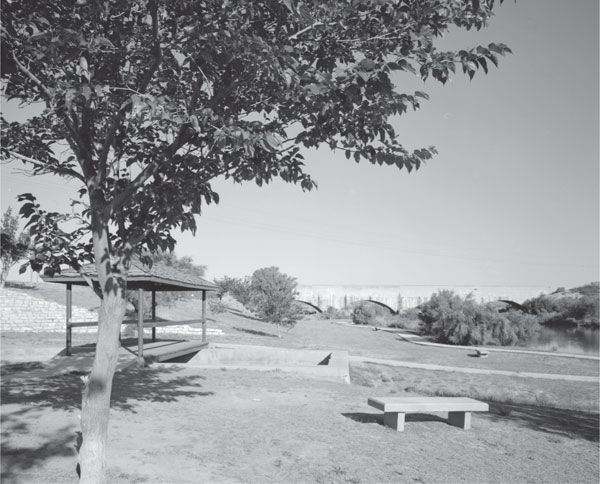
The Springs of Carlsbad were thought to have healing qualities. In 1891, the spring produced more water than what was used by Denver, Colorado. Courtesy of the Southeastern New Mexico Historical Society.
2
CARLSBAD
HISTORIC CARLSBAD
Carlsbad began life as Eddy, New Mexico, in 1888, named after its founder, Charles Bishop Eddy, a cattleman from New York State. If Eddy was created today, it would have been one of the biggest real estate promotions ever known. At the time, Eddy was founded on a wing and a prayer with the vision and drive of one man (Eddy), who accomplished an amazing publicity feat, attract people from around the world to settle in a flat piece of land in the middle of a desert.
It was Eddy’s dream to have the perfect society free of vice of any kind—especially alcohol, since he was a teetotaler. As a former resident of Colorado City, Colorado, Eddy was determined to model his new venture after his favorite Colorado town. The saving grace for the region was the Pecos River, which Eddy saw as a huge asset and set out to literally cash in on its potential.
Local cowboys dubbed the area Rattlesnake Flats due to the extremely large population of rattlesnakes in the region. Running cattle through this rangeland was exceedingly dangerous, not only because of the venomous snakes, but also because of the snake holes, which could turn the ankle of a horse or steer in an instant. Rattlesnake derbies became a favorite sport in subsequent years and helped to clear out the reptile population considerably while raising money for local causes.
Investors and settlers alike were unable to resist Charles Eddy’s charisma, and the town grew by leaps and bounds to become the county seat. Soon, the small hamlet in the southeast corner of New Mexico was home to immigrants from Italy, Switzerland and Germany. Due to one of the largest irrigation projects in the United States, contrived by Charles Eddy, Charles Greene, J.J. Hagerman and Pat Garrett (of Billy the Kid fame), the town of Eddy was an agricultural wonder. Crops of cotton, grapes, alfalfa and sugar beets, as well as orchards of peaches, sprang from the arid desert landscape to thrive and produce large yields.
Fruits and vegetables from Eddy County won multiple awards at county and state fairs, as well as at the Chicago World’s Fair. The alkaline terroir of the soil made it possible for crops to flourish. Today, pecans, cotton and alfalfa are the largest products of the area.
Once the railroad came to Carlsbad in 1890, getting crops to market was much easier; the town truly became connected to the rest of the country. Carlsbad garnered its name after Charles Eddy left the town to start enterprises elsewhere. A spring that feeds into the Pecos River was found to have the same mineral contents as the healing springs in Karlovy Vary, or Carlsbad, a famous thermal springs spa in what is now the Czech Republic. The decision was made by founding citizens Robert and Mary Tansill, who had visited the healing springs abroad, to adopt the new name in honor of the mineral water.
Plans for a sanatorium, bathhouse, cabins and tent city at Carlsbad Springs were devised in 1904 by a newly formed company, spearheaded by local physician Dr. Doepp. Unfortunately, the bathhouse was the only structure ever built. The spring was the main source of fresh water for many of the new residents. In 1911, a petition was placed before the town board of trustees to change the name of Carlsbad to Carlsbad Springs, which failed.
In 1926, one of the largest deposits of potash was found east of Carlsbad by geologist V.H. McNutt, who was looking for oil when the core sample produced an equally valuable treasure. A residue of ancient forest fires, potash is primarily used as a fertilizer for crops because of its rich potassium content. This mineral discovery was especially important during World War I and World War II, since Germany was at that time the only source, and the country cut off supply to the United States. Potash has since supplied Carlsbad with a steady source of income and livelihoods.
Carlsbad flourished and would be home to the world-famous Carlsbad Caverns National Park, an Army airfield training bombardiers (including several classes from China) and German prisoner-of-war camps in World War II, plus many participants in the tragic Bataan Death March. A few survivors and their families still reside in Carlsbad today. Also, those who called Carlsbad home were well-known politicians, scientists, actors, artists, singers, writers, military heroes, astronauts, athletes, race-car drivers, oilmen and cattlemen.

The Springs of Carlsbad were thought to have healing qualities. In 1891, the spring produced more water than what was used by Denver, Colorado. Courtesy of the Southeastern New Mexico Historical Society.
Many would be surprised to know that actor Dan Blocker (Hoss Cartwright on Bonanza), actor Bruce Cabot (King Kong), race-car driver Dick “Mr. Chevrolet” Harrell, famed artist Roderick Mead, baseball hero Cody Ross, Staff Sargent Barry Sadler (who wrote and sang the “Ballad of the Green Berets”) and astronaut F. Drew Gaffney, to name but a few celebrated individuals, are claimed by Carlsbad.
CARLSBAD TODAY
Modern-day Carlsbad is fueled by tourism from the nearby Carlsbad Caverns National Park, which draws well over half a million visitors to the area each year, as well as the Living Desert Zoo and Gardens State Park, home to indigenous plants and animals of the Chihuahuan Desert, in which Carlsbad is located. There are also the potash mining industry, the oil and gas industry and the Waste Isolation Pilot Plant (WIPP) (a unique, safe nuclear waste depository), all of which provide an ample supply of employment for the region.
The Pecos River, which meanders through the heart of Carlsbad, is still the lifeblood of the region and continues to attract fishermen, boaters, walkers and swimmers nearly year-round due to the moderate climate the area enjoys. The city has installed a water park and splash pads for residents and tourists alike. Recent expansions include a splash zone for children and residents with disabilities called Friendship Park.
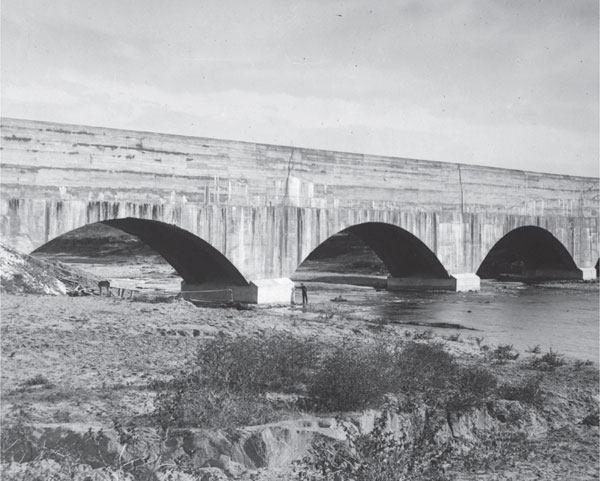
The Pecos River is the lifeblood of the Pecos Valley, providing much-needed irrigation to the arid landscape via a concrete flume. Courtesy of the Southeastern New Mexico Historical Society.
During the holiday season, residents who live along the banks of the Pecos River create magical light displays in their backyards for boat tours to view. This event, called Christmas on the Pecos, runs from the Friday after Thanksgiving to New Year’s Eve. Nationally acclaimed for its beauty, the boat tours have become a favorite annual destination for many tourists. The event grows as more and more lights are added to backyards, bridges, golf courses and an island along the smooth Pecos River. The Carlsbad Navy provides the safe navigation of large party barges every night. Recently, helicopter rides have been offered to those who want to witness the splendor from the sky.
Sports play a big part in Carlsbad life; the Bob Forrest Youth Sports Complex was built to accommodate the many events the city hosts each year. These state-of-the-art facilities include fields for baseball, softball, football and soccer, as well as their own refreshing splash pads, which can be used any time, whether one has friends or family members participating in sports.
Carlsbad is home to several microbreweries, including Milton’s Brewing, Guadalupe Mountain Brewing Company and the Lucky Brew, which bring in many wonderful musical talents from around the region while providing handcrafted beer to taste. Also, the Balzano family—owners of the Trinity Hotel—has a winery at their vineyard about twelve miles north of Carlsbad at Seven Rivers and has branched out to include an annual pumpkin patch with a petting zoo in the month of October and an antiques fair in November. The winery is also a beautiful wedding venue complete with a full-sized Cinderella coach.
As with most towns in the United States, Carlsbad has seen lean times, but its resilience has been inspiring. Its growth has always been steady, but Carlsbad is currently experiencing a boom due to the oil industry, which has attracted many new businesses to the Cave City. The once sleepy small town is now bustling with activity and easily triples in size during the workweek. It has a bright future.
THE TRINITY HOTEL
Built in 1892, the Trinity Hotel started out as the First National Bank building and the home of the first newspaper for Eddy (soon to be renamed Carlsbad). Renovated in 2007, the two-story building was on the brink of disaster, appearing on New Mexico’s “Endangered Historic Buildings” list before three partners took on the monumental task of bringing this magnificent structure back to its former glory. Previous office spaces are now nine beautifully appointed hotel suites.
In its rich history, the Trinity also served as an office site for Carlsbad (Eddy) founder Charles B. Eddy and Sheriff Pat Garrett. In recent history, it was the home of the Carlsbad Irrigation District offices. It was through a loan from the Revolving Loan Fund (RLF) and local support that the renovation of the historic building was possible.
“When my partners and I started on this project, we wanted to create something totally different in Carlsbad,” said Dale Balzano, owner of the Trinity Hotel. “Without the support of the RLF Program, this project would never have come to fruition.”
The owners of the hotel and restaurant, father and son Dale and Derrick Balzano, along with partner Michael Moore, in the words of Dale Balzano, painstakingly “adhered to the rigid standards of New Mexico and United States Department of the Interior for Historic Preservation to transform the crumbling edifice into the Trinity Hotel.” The hotel now holds a proud spot in the National Register of Historic Places and has been thankfully preserved for future generations to enjoy.
Today’s boutique hotel offers amenities including wine chillers, flat-screen TVs, docking stations, free Wi-Fi access, as well as the special plush Trinity robes. Some of the exquisitely designed suites include sunken bathtubs to bring even more luxury to a visitor’s stay. The Victorian Italianate style of the hotel stands out against the surrounding mostly adobe/pueblo style of architecture on a historic corner in Carlsbad.
Free wine tasting is available in the Trinity dining room from 3:00 p.m. to 7:00 p.m. daily. This gives patrons an opportunity to taste the many spectacular wines not only of the Balzano Vineyards but also of the state of New Mexico itself. Boasting the oldest wine industry in the United States, New Mexico has some excellent, award-winning vintages that will be sure to please even the most discerning palate.
Janie Balzano, wife of Dale, serves as chef for the delicious menu the Trinity provides. Italian dishes dominate the wide selection, but delectable steaks and seafood are also available. New additions to the menu can be found each week, so visitors should go back often. These delightful plates can be paired with the Trinity Hotel’s signature wine, The Spirits of Seven Rivers, as well as other New Mexico tasty wines. Breakfast and lunch menus are also available to start your day off right. Many of the dish names have historical ties to the Trinity and to the Carlsbad area.
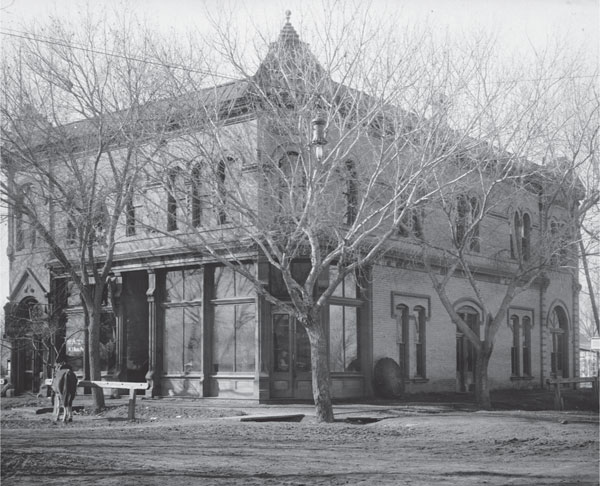
The First National Bank building, shown in this 1905 image, now known as the Trinity Hotel, has seen Carlsbad grow from this corner since 1892. Courtesy of the Southeastern New Mexico Historical Society.
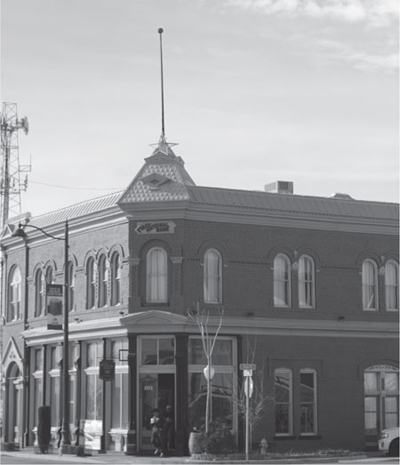
The Trinity Hotel is one of the few remaining buildings in Carlsbad that dates to the 1800s. This hotel has stood the test of time. Courtesy of the author.
The Trinity Hotel gives back to the community is many ways, one being providing free Thanksgiving meals for anyone who wants one. This tradition was started by fellow restaurant owner Pete “The Chef ” Panagopolous of the now closed Deluxe Café. He would prepare free Thanksgiving meals for all. Dale Balzano, owner of the Trinity Hotel, was quoted in a Current Argus staff article: “I was always struck by Pete Panagopolous’ generosity, and I knew that someday I wanted to be in a position to give back to the community the way he did for so many years. This is our way of saying thank you to Carlsbad and thank you to Pete for the generosity of spirit that he exemplified through his giving.”
Janie Balzano makes a delightful traditional meal of turkey, stuffing and dessert. She expects to feed at least five hundred people each year. It is certainly a labor of love.
Gleaming original wooden floors, pressed tin ceiling and heart-stopping crystal chandeliers welcome the many patrons of the Trinity Hotel. A massive mirrored-back bar sits directly in front of you as you enter the dining room from the lobby gift shop. You will be given the option of being seated downstairs or upstairs; both have excellent benefits. Downstairs, you are in the mix of things; upstairs, you get a bird’s-eye view of the restaurant below. The resident ghost, Ruby, prefers the upstairs.
GHOSTS
Miss Ruby has been making her presence known to the Trinity Hotel staff since the hotel opened in 2008. Generally hanging out in her favorite spot on the second floor of the restaurant in a secret room (be sure to ask your server to show you the entrance to this room), Ruby is said to patiently watch the staff as they prepare the tables for the day’s patrons. She also has definite opinions on music and has been known to turn off the sound system when a song she deems offensive comes on. The friendly spirit also likes to call the staff by name.
Ruby is thought to be the former secretary of the Carlsbad Irrigation District around 1888. Her favorite room to haunt is 206 (which contains the vintage safe). It was also originally her office. Rooms 201, 206 and 207 were one big office during her time; the Balzanos sectioned them off to make the hotel rooms we know today. Ruby is still protective of her office space.
Ruby is also a prankster who likes to pick on single females who stay in her room. She is known to be very inventive in her pranks, as one guest reported to Dale Balzano. He told the owner that he and his family awoke one morning and looked for the towels in the restroom, only to find them on top of the window ledge. Mind you, these windows are approximately seventeen feet tall, with the sill being another two feet off the floor, for a total of nineteen feet. There was no means by which the towels could have been placed that high in the room. A ladder had to be used to retrieve the objects for the family.
Ghost hunters who investigated the property also told the owners of another spirit that resides there. This apparition is allegedly of a caretaker who worked at the Trinity building for forty years. The staff and owners call him the “Glass Breaker” because of his propensity to break glassware to show his disapproval.
Stories are also told of the hotel’s vineyards, located twelve miles north at Seven Rivers, being haunted. Hence the reason behind the wine label, The Spirits of Seven Rivers. The Seven Rivers cemetery had to be moved due to the construction of Brantley Dam, a diversionary dam originally slated to cover most of the Seven Rivers area. Due to this disturbance of the graves, it is said that a cowboy on horseback will sometimes be seen coming through the wall of the grape-processing building. A little girl has been reported playing among the grapevines.
These reports ring true with the description of the graves as documented and relocated by an archaeological team. Seven Rivers has long had the reputation as being the most violent town in New Mexico (in the 1880s), and it was written in the local newspaper that you could read the paper by the light of gunfire at night. When the graves were opened, the town’s violent past became evident, as most of the graves presented bullets. Not too many citizens died of natural causes.
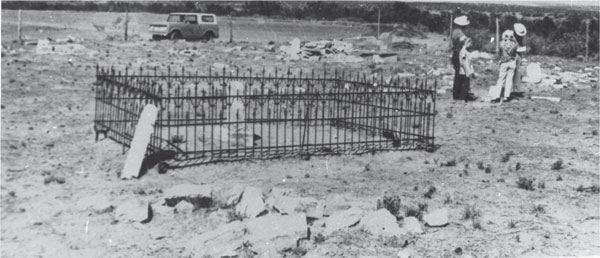
Located in Seven Rivers, the frontier cemetery was moved north to the Twin Oaks Cemetery of Artesia, New Mexico, due to the construction of Brantley Dam. Courtesy of the Southeastern New Mexico Historical Society.
Dale Balzano reports that the New Mexico State Police has told him that it considers the one-mile stretch of road in front of the tiny hamlet of Seven Rivers to be one of the most haunted stretches of highway in the state. They have records of people going off the road to avoid a woman in a white dress crossing the highway, as well as other apparitions that seem to appear out of nowhere.